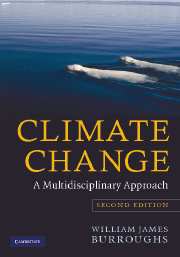Book contents
- Frontmatter
- Contents
- Preface to the second edition
- 1 Introduction
- 2 Radiation and the Earth's energy balance
- 3 The elements of the climate
- 4 The measurement of climate change
- 5 Statistics, significance and cycles
- 6 The natural causes of climate change
- 7 Human activities
- 8 Evidence of climate change
- 9 Consequences of climate change
- 10 Modelling the climate
- 11 Predicting climate change
- Glossary
- Bibliography
- Index
Preface to the second edition
Published online by Cambridge University Press: 05 June 2012
- Frontmatter
- Contents
- Preface to the second edition
- 1 Introduction
- 2 Radiation and the Earth's energy balance
- 3 The elements of the climate
- 4 The measurement of climate change
- 5 Statistics, significance and cycles
- 6 The natural causes of climate change
- 7 Human activities
- 8 Evidence of climate change
- 9 Consequences of climate change
- 10 Modelling the climate
- 11 Predicting climate change
- Glossary
- Bibliography
- Index
Summary
Since the first edition of this book was published in 2001, the subject of climate change has grown from just one of a number of pressing environmental issues to being seen as comparable with terrorism and nuclear proliferation as one of the greatest threats to humankind. Why has this dramatic change occurred? The principal reason is summed up in a quip by the British Prime Minister, in the late 1950s/early 1960s, Harold Macmillan. When asked by a young journalist after a long dinner what can most easily steer a government off course, he answered, “Events, dear boy. Events”.
The climate has been anything but uneventful in recent years. The inundation of New Orleans, the European heat wave of 2003 and the accelerating melting of polar ice sheets are widely seen as examples of how climate change is a growing threat to the planet. It is not just the scale of these events but also the sense of inadequacy of our preparedness for managing adverse events and how this requires us to think in a multidisciplinary way in our preparedness. This wider thinking has inspired politicians to express far greater commitment to action on climate change. In part, this is the realisation that the first step had to be to sign up to and express commitment to the Kyoto Treaty of 1997. Then there was the remarkable impact of one of their number – Al Gore.
- Type
- Chapter
- Information
- Climate ChangeA Multidisciplinary Approach, pp. ix - xiiPublisher: Cambridge University PressPrint publication year: 2007



